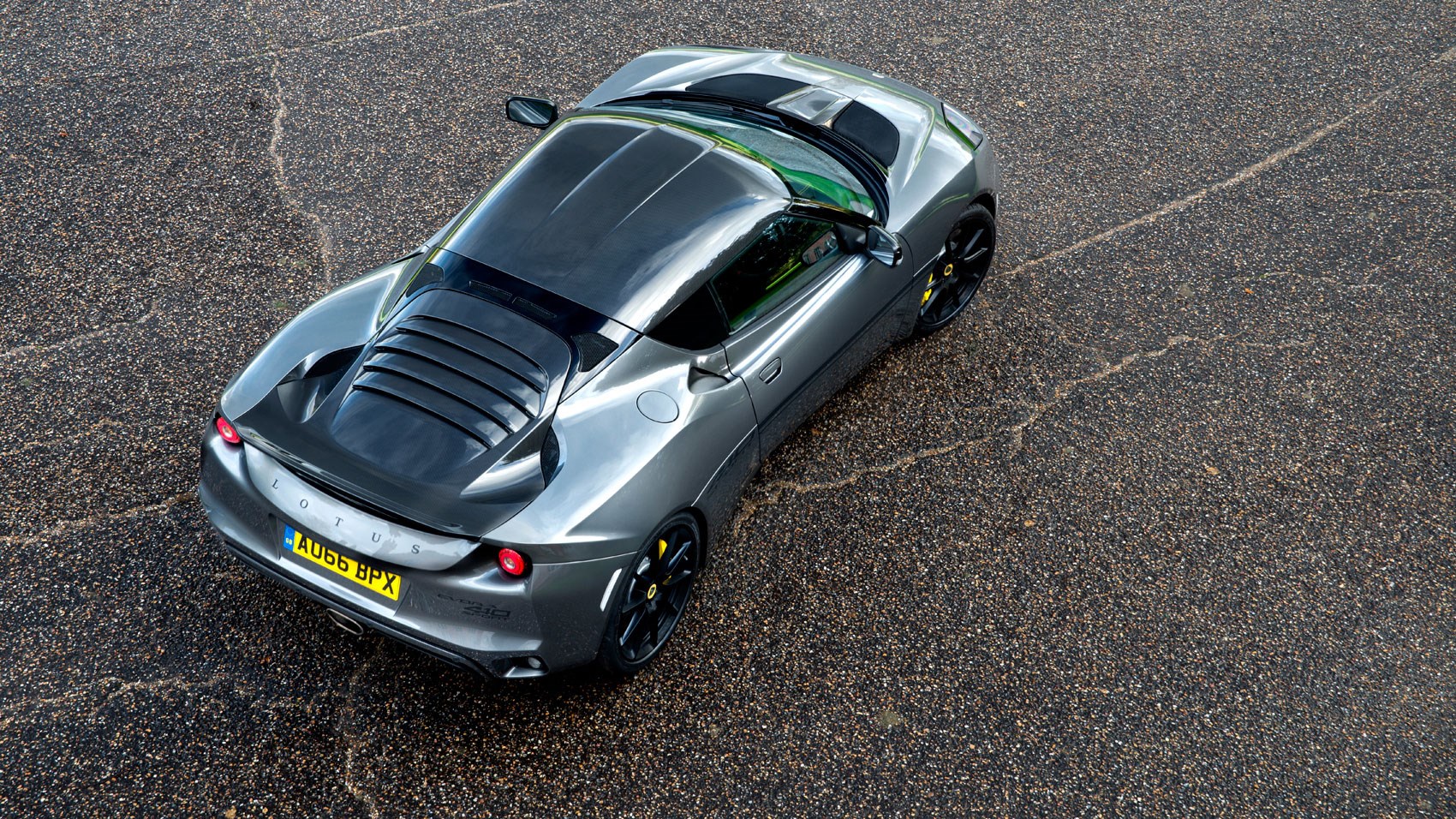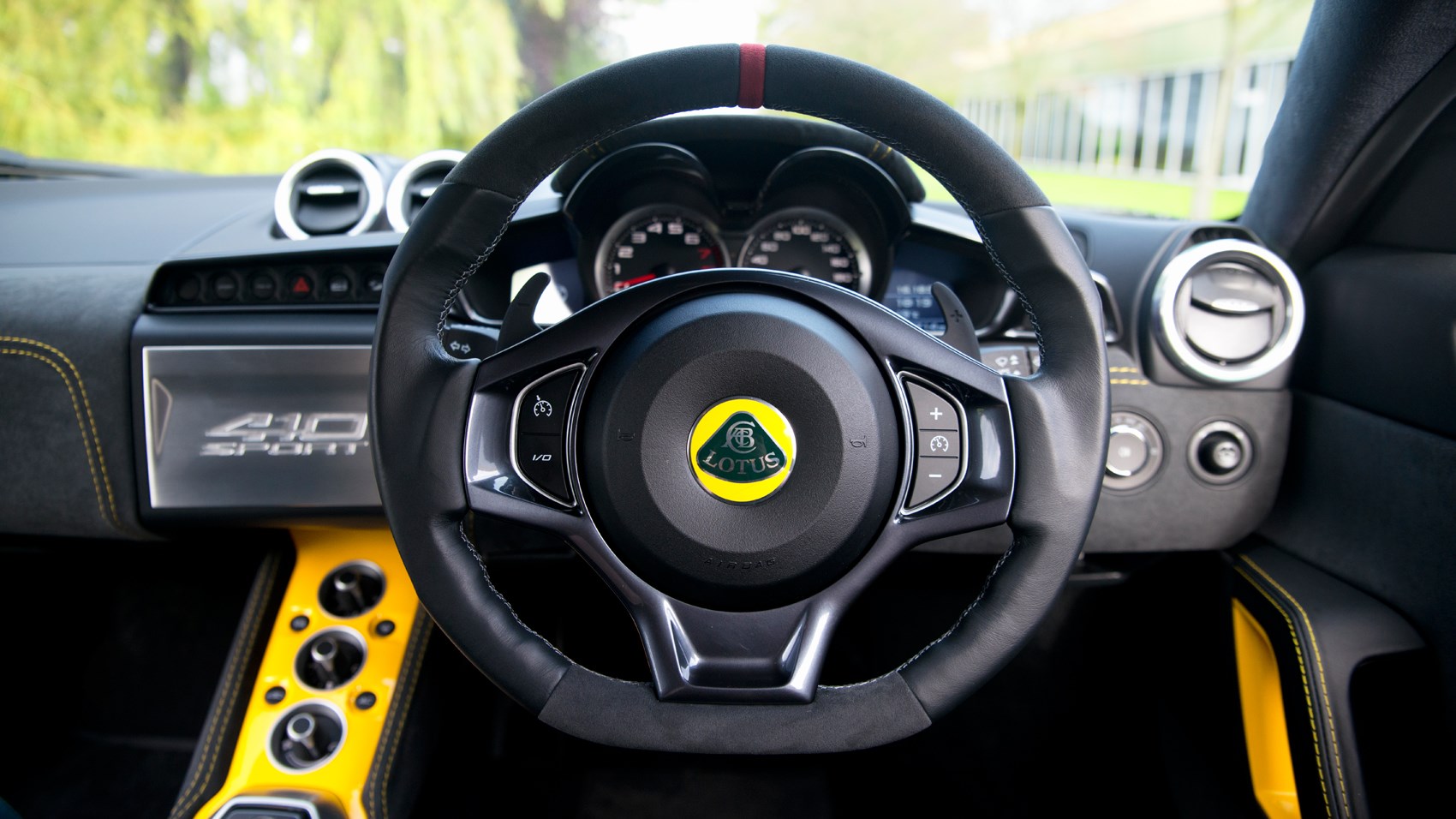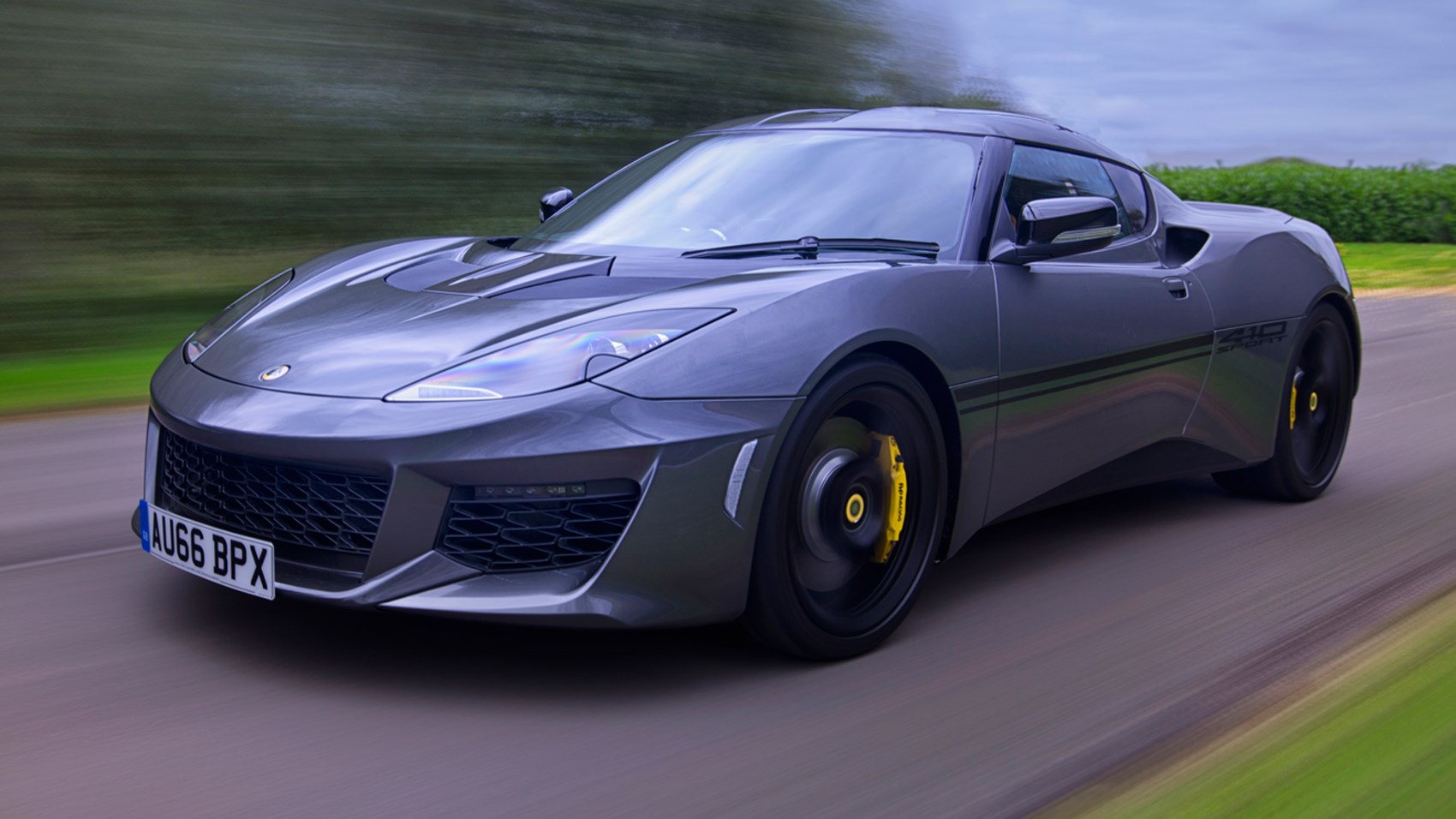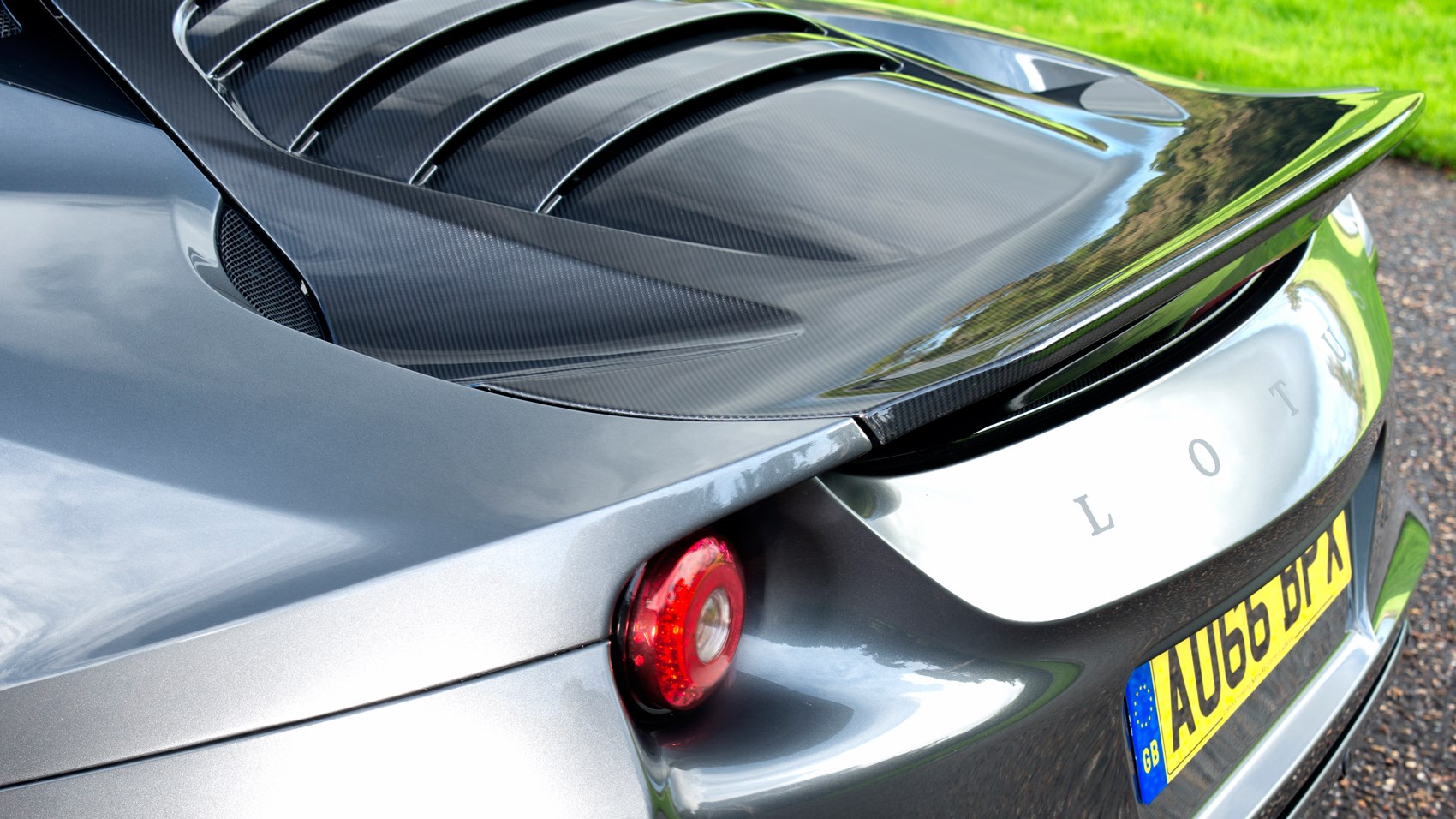► The quickest, most focused Evora there is
► 150 cars to be built per year; each to cost £82,000
► A full 70kg lighter than the regular Evora 400
‘Sport’ is to Lotus as ‘GT3’ is to Porsche, or ‘Speciale’ is to Ferrari. Remember the lighter, faster Esprit Sport 350, complete with ’90s-spec decals and scaffold rear wing? The Evora Sport 410 is cut from the same cloth. Or, in this case, carbonfibre – and lots of it.
What are the differences between a standard Evora 400 and a Lotus Evora Sport 410?
When Lotus superseded the original Evora range with the quicker, lighter and altogether more well-rounded Evora 400 in 2015, it was rightly proud of a net 42kg decrease in kerb weight – even after taking into account the addition of bigger, heavier brakes.
This makes the fact that the new Sport 410 weighs a full 70kg less than the 400 (or 80kg less with the new, optional titanium exhaust system) all the more startling.
With fluids, its kerb weight now measures 1325kg (the car might be lightweight, but its 3.5-litre supercharged V6 engine and its associated plumbing is less so). As the name suggests, power output’s been tickled from 400 to 410bhp, all courtesy of ECU ones and zeroes rather than any mechanical changes.
That makes for a dry power-to-weight ratio of 323bhp per tonne, and its top speed has increased to no less than 190mph. Proper supercar figures, then, for a car that began its lifespan as a sports coupe.
It’s a full three seconds a lap quicker round Lotus’s Hethel test track than the Evora 400, too; it also doesn’t so much tread on its Exige sibling’s toes as break them, as the 410’s a full second quicker over a lap than the outwardly more extreme Exige Sport 350.
How much does it cost?
The starting price is a not-inconsequential £82k, compared with the regular Evora 400’s £73,500 at the time of writing. On the 410’s side is rarity – only 150 will be built each year, including a run for the USA from 2017 – and some expensive upgraded parts.
I thought the Evora 400 had already been made as light as possible? Where have all these extra savings come from?
Part of the Sport 410’s development team’s to-do list was to lower the car’s centre of gravity as well as its kerb weight, so the flab-fighting begins from the top down. The roof is now carbonfibre, as is the tailgate.

There’s no glass rear screen now, either, just a one-piece carbon panel with Stratos-esque louvres to peek through that blends into an elongated ducktail-style lip. It’s now light enough to do without gas struts – another couple of kilos lost, for a 12kg total. The end result is a centre of gravity that’s 12mm lower. In the lightweight sports car world, that’s not to be sniffed at.
Can you actually see out of the back?
You can, although it’s admittedly not the clearest view in the world. Parking sensors help, though.
To balance out the longer spoiler surface at the back, a 35mm more pouty front lip spoiler has also been added, giving the 410 twice the downforce of the Evora 400 at top speed (64kg vs 32kg). Conversely, the drag coefficient has dropped a little, from 0.36 to 0.35, partly thanks to a 5mm drop in ride height.
Even the glass for the rear quarter windows has been swapped for carbon, and the porthole in the bulkhead is now one layer of glass rather than two.
That still doesn’t sound like it adds up to 70kg?
The 410 is a two-seater only – you can’t have it as a 2+2 (no great loss if you’ve ever tried sitting in the back of an Evora) – and the seats themselves are the thinnest buckets I’ve ever seen bolted into a car, road or race. They’re made on site at Hethel and they’re the same design Lotus has used in the racing variants of its cars for the past 20 years or so, and weigh just 6kg each, clad with a thin skin of either leather or Alcantara. If you bruise easily, you can option the Evora 400’s adjustable Sparco seats back in, at a weight penalty of 18kg. Tsk.
Likewise, 1kg’s been trimmed from each door thanks to one-piece panels, again trimmed in alcantara, minus armrests and speakers. Yep, there’s no radio/sat-nav/reversing camera unit as standard, although it can be optioned back in at a cost of £2000. Same deal for air-con, at £1500. This is a car for the most committed of driving enthusiasts only…

If one thing keeps engineers awake at night more than centre of gravity, it’s rotating mass – and the Evora’s shed some of that too. The reductions come from new forged aluminium wheels with 10 impossibly skinny spokes. They’re made in a similar way to the McLaren 675LT’s and they drop 7.2kg in total from the Evora’s regular footwear.
There’s also less sound insulation, no mudflaps (again, they can be optioned back in), and decals in place of badges to save a whole 50g. It really is a bare minimum kind of car.
Any suspension changes?
New dampers, firmer on compression at the rear and firmer on rebound at the front, with the aim of reducing roll and making the car sit up quicker after a fast corner more quickly. The aforementioned 5mm drop in ride height helps cut body roll too.
The springs are unchanged, but with less mass to lift their spring rates have effectively been increased slightly. There’s a touch more negative camber at the back, too, and more toe-in at the front. Brakes are unchanged from the regular 400 – there’s no need to upgrade them, after all, given that they measure 370mm at the front already and have less to stop.
Sticky, shallow-grooved Michelin Pilot Sport Cup 2 tyres are fitted as standard rather than the 400’s more conventional Pilot Sports, and contribute in no small part to that lap time.
Enough tech talk. What’s it like to drive?
It’s a more uncompromising machine than the Evora 400, in more ways than one. Once you’ve clambered into the wafer-thin bucket seats (an easier process than Evoras of old, thanks to the cut-down sills that were part of the 400 overhaul) you’ll find a thoroughly spartan interior. What looks like the lid from a tin of boiled sweets blanks off the hole where the radio/nav unit would usually be, and apart from a narrow glovebox with a USB connection, there’s nowhere to put any belongings (and said glovebox needs a good slam to close too; hopefully a pre-production niggle rather than a common flaw).
There’s nowhere to put your elbows, either – this is a car which invites to place both hands on the wheel, and keep them there. All the better to enjoy that typically lovely hydraulically assisted steering, which on the Cup 2 tyres is every bit as fluid and feelsome as you’d hope.

Less fluid is the ride quality; Lotuses traditionally have spookily comfortable suspension on bumpy roads, but the uprated dampers and lighter mass make the Sport 410 an unyieldingly firm machine on the lumpy roads around Lotus HQ. In a world of performance cars with endlessly configurable damper settings to play with, the Evora’s fixed setup is actually a welcome tonic. You just get in and drive it, pure and simple.
As you’d expect given the amount of sound deadening and glass that’s been deleted, road noise is much more evident than in the 400 too. So is the engine, and that’s no bad thing. The 3.5-litre supercharged V6, Sound engineered’ from the outset when the 400 update package was installed, is far more evocative than an engine that began life in a Toyota Camry has any right to be, with a howling note that could have been recorded straight from the Mulsanne Straight.
As standard, it’s hooked up to a six-speed H-pattern manual, which these days is a much less baulky proposition than that of the original Evora, thanks to tightened-up cables. A torque converter auto is an option. We drove both and the latter works perfectly well, but simply can’t be respond as snappily as a dual-clutch ’box. Ninety percent of customers will choose the manual – it’s that sort of car, after all. And there’s so much torque you can leave it in third gear everywhere anyway…
What’s it like on track?
Predictably brilliant, with wonderfully neutral handling. You can make it oversteer, understeer, or do both at the same time and it’ll happily indulge you, but does its best work being driven neatly and tidily. One eyebrow-raising handling characteristic is a tendency to get up on its toes under braking and begin to rotate, but that keenness to change direction is no doubt one of the things that helped the 410 to its Exige-beating lap time.
You can progressively relax the stability control and ABS in Sport and Race modes, and both systems are so unobtrusive in the latter setting you’d swear they were switched off altogether – most of the time.

Lotus says the 410, thanks to its downforce and tyres, can carry a full 10mph over the regular Evora 400 through the circuit’s fastest corner (the daunting ‘Windsock’ right-hander). I found my back sliding around in the seat at this point on the track; although the seats are supportive on the road, it feels like they’d work better with the multi-point harnesses they were originally designed for rather than three-point inertia reel belts on track. They left me with similar bruises to our Radical SR1 long-termer, too…
You haven’t mentioned the Porsche Cayman GT4 yet
Do I have to? I suppose I should. As extensively developed, more hardcore versions of brilliant base coupes, both cars do have a very similar remit, and similar weights for that matter.
The Porsche would be easier to live with on a day-to-day basis, thanks to its more generous equipment count, adaptive dampers for a smoother ride, friendlier ergonomics, better positioned pedals and a more positive-feeling gearshift with useful automatic rev-matching. With a budget that dwarfs the Evora’s, interior quality is on another level too. But both cars feel similarly agile on road and track, and are both among the most engaging sports cars to drive in the world today. Mind you, the GT4’s sold out now anyway.
Verdict
The Sport 410 doesn’t supersede the Evora 400; it continues alongside it as a kind of ultra-focused, triple-distilled derivative. Its pared-back interior and uncompromising ride (and price) narrow its appeal to a customer base as keenly focused as the car itself. If you’re prepared to suffer for your art, driving thrills don’t come much purer.
Read more Lotus reviews